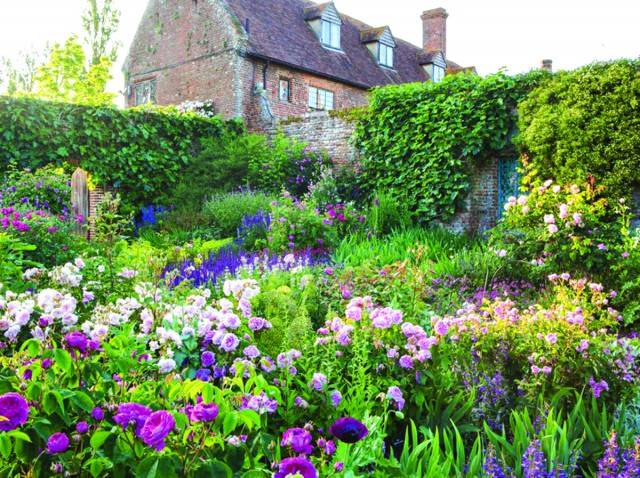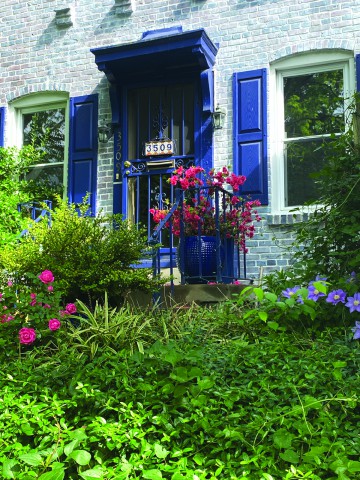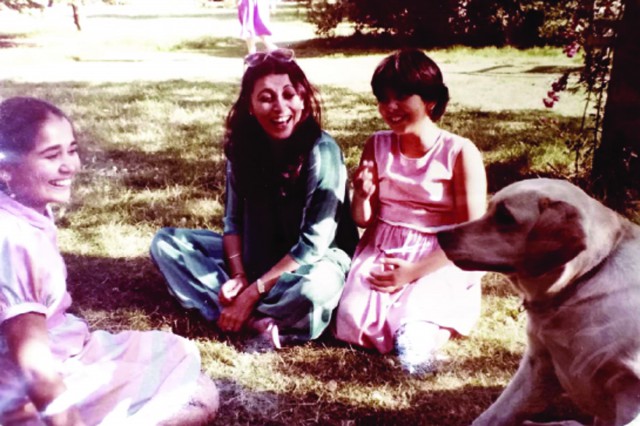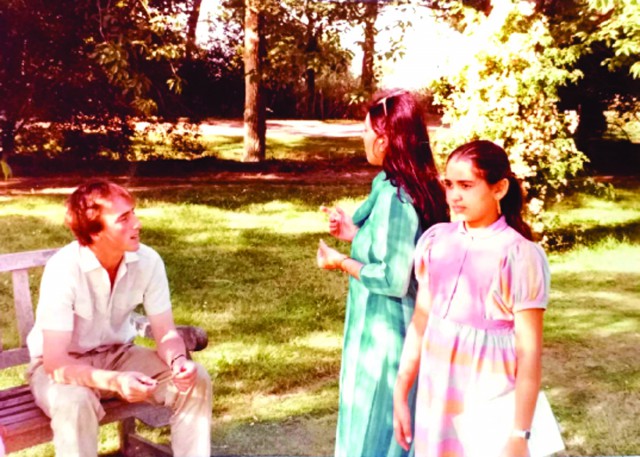
I will never forget the day when we visited the gardens of Sissinghurst Castle in Kent, UK. I was a shy young ten-year old and had just finished reading The Secret Garden, a magical book about enchanted gardens. Sissinghurst is the garden of one’s dreams: colour-themed gardens with rose, white and purple blossoms, a small but perfect white garden consisting of only silvery-white bushes, a shaded lemon grove, and surrounding the castle gardens, fruit-laden orchards. This sort of garden takes a lifetime to develop.
It took in fact two lifetimes: that of the biographer/historian Harold Nicolson and his wife the poet/novelist Vita Sackville-West. They bought Sissinghurst Castle in 1930, a ramshackle Elizabethan manor with two tall towers and little else. It was more a ruin than a potential home. Yet, they devoted their lives to restoring it and creating one of the most visited gardens in England.

The house and its gardens are an enduring symbol of their artistic creativity. Together, over a period of thirty years, they designed and organized a whole pattern of linked gardens. Nicholson, as the master planner, provided the architectural framework - drawing the skeleton of the garden, its firm classical lines of hedges, choosing the right creepers to climb its ancient walls. Vita, who published a weekly column for 14 years on horticulture, used her wild romanticism to infuse poetry into each garden – the now celebrated White Garden, Rose Garden, the Cottage Garden and Nuttery.
The whimsical gardens, which have survived to this day, are firmly established as one of the British gardens to visit.

During my visit on a perfect July day in 1984, our family sat on a bench in the grounds of Sissinghurst, ate sandwiches, and played with a golden Labrador. We started chatting to the dog’s owner and discovered that the young man was Adam Nicolson, the winsome grandson of Vita and Harold. Although still in his early twenties, he had inherited their talents. Over subsequent years, he has transformed the 260 acres of land around Sissinghurst Castle (now owned by The National Trust but available to the Nicholson family in perpetuity) into a productive commercial farm.
Adam’s grandmother Vita Sackville-West lived in splendid isolation in the rooms in the central Elizabethan tower. As an active member of the Bloomsbury Group, which included Virginia Woolf and similar luminaries, she imbued Sissinghurst with their core themes of love, art and the pursuit of knowledge in the creation of her landscape. From her study she could literally oversee the five-acre garden as it matured over the years until her death in 1962. I can only hazard a guess as to how much joy these gardens must have brought her – as with any creative activity, to plan and visualize gardens and blooms and for the cyclicality of seasons to create a sense of magic and colour.

As a child, to visit a place like this was like another world – of beauty, imagination and secret treasures. The rose bushes were like clouds of roses on red brick walls: one could go from one garden to the next and chance upon hidden gardens and sculptures. It was like entering into Frances Scott Burnett’s Secret Garden and her wise words “if you look the right way, the whole world is a garden”.
This visual image has stayed with me for years – and probably germinated my love of spectacular gardens. Over the past three decades, wherever I travel. I look out for beautiful or unusual gardens where one can sit and paint or write, if one has the time. They are a source of private joy as well as of spiritual nourishment. One experiences natural peace in a garden and the sense of just being at one with nature.

In my own small garden in Washington DC, my husband and I sought to create a sense of magic – whether through whimsical herb patches, rose bushes and azaleas which remind us that spring has sprung and at night the candle lit space feels like a secluded getaway. On a recent trip to Savannah, we had the same experience through visiting the Magnolia Plantation – a series of beautiful hidden gardens which had the same whimsical romantic overgrown vibe. In the US this happens to be in the form of canopies of live oaks, lakes with alligators and vines, but the sense of peace was palpably the same.
So as we all muddle our way through the various stages of the pandemic, whether in secluded peace in Ramadan or thinking of the ones who are suffering more than us, I would urge you to seek pleasure in creating one’s own beauty - whether the careful cultivation of a single plant or an entire garden.
Ours may not be a Sissinghurst but I empathise with share Harold Nicolson’s deep sense of satisfaction and accomplishment as he surveyed what he and Vita had created. On a particularly glorious evening, when the surrounding countryside was ‘bathed in golden light’, Nicholson wrote in his diary on the 17th of April 1949: “The garden looks so rich from the eminence [...] It truly is a most beautiful garden - so varied, so calm, so enclosed. It is a garden I should envy much if it belonged to some else.”
It took in fact two lifetimes: that of the biographer/historian Harold Nicolson and his wife the poet/novelist Vita Sackville-West. They bought Sissinghurst Castle in 1930, a ramshackle Elizabethan manor with two tall towers and little else. It was more a ruin than a potential home. Yet, they devoted their lives to restoring it and creating one of the most visited gardens in England.

The house and its gardens are an enduring symbol of their artistic creativity. Together, over a period of thirty years, they designed and organized a whole pattern of linked gardens. Nicholson, as the master planner, provided the architectural framework - drawing the skeleton of the garden, its firm classical lines of hedges, choosing the right creepers to climb its ancient walls. Vita, who published a weekly column for 14 years on horticulture, used her wild romanticism to infuse poetry into each garden – the now celebrated White Garden, Rose Garden, the Cottage Garden and Nuttery.
The whimsical gardens, which have survived to this day, are firmly established as one of the British gardens to visit.

During my visit on a perfect July day in 1984, our family sat on a bench in the grounds of Sissinghurst, ate sandwiches, and played with a golden Labrador. We started chatting to the dog’s owner and discovered that the young man was Adam Nicolson, the winsome grandson of Vita and Harold. Although still in his early twenties, he had inherited their talents. Over subsequent years, he has transformed the 260 acres of land around Sissinghurst Castle (now owned by The National Trust but available to the Nicholson family in perpetuity) into a productive commercial farm.
Our family sat on a bench in the grounds of Sissinghurst, ate sandwiches, and played with
a golden Labrador. We started chatting to the dog’s owner and discovered that the young man was Adam Nicolson, the winsome grandson of Vita and Harold
Adam’s grandmother Vita Sackville-West lived in splendid isolation in the rooms in the central Elizabethan tower. As an active member of the Bloomsbury Group, which included Virginia Woolf and similar luminaries, she imbued Sissinghurst with their core themes of love, art and the pursuit of knowledge in the creation of her landscape. From her study she could literally oversee the five-acre garden as it matured over the years until her death in 1962. I can only hazard a guess as to how much joy these gardens must have brought her – as with any creative activity, to plan and visualize gardens and blooms and for the cyclicality of seasons to create a sense of magic and colour.

As a child, to visit a place like this was like another world – of beauty, imagination and secret treasures. The rose bushes were like clouds of roses on red brick walls: one could go from one garden to the next and chance upon hidden gardens and sculptures. It was like entering into Frances Scott Burnett’s Secret Garden and her wise words “if you look the right way, the whole world is a garden”.
This visual image has stayed with me for years – and probably germinated my love of spectacular gardens. Over the past three decades, wherever I travel. I look out for beautiful or unusual gardens where one can sit and paint or write, if one has the time. They are a source of private joy as well as of spiritual nourishment. One experiences natural peace in a garden and the sense of just being at one with nature.

In my own small garden in Washington DC, my husband and I sought to create a sense of magic – whether through whimsical herb patches, rose bushes and azaleas which remind us that spring has sprung and at night the candle lit space feels like a secluded getaway. On a recent trip to Savannah, we had the same experience through visiting the Magnolia Plantation – a series of beautiful hidden gardens which had the same whimsical romantic overgrown vibe. In the US this happens to be in the form of canopies of live oaks, lakes with alligators and vines, but the sense of peace was palpably the same.
So as we all muddle our way through the various stages of the pandemic, whether in secluded peace in Ramadan or thinking of the ones who are suffering more than us, I would urge you to seek pleasure in creating one’s own beauty - whether the careful cultivation of a single plant or an entire garden.
Ours may not be a Sissinghurst but I empathise with share Harold Nicolson’s deep sense of satisfaction and accomplishment as he surveyed what he and Vita had created. On a particularly glorious evening, when the surrounding countryside was ‘bathed in golden light’, Nicholson wrote in his diary on the 17th of April 1949: “The garden looks so rich from the eminence [...] It truly is a most beautiful garden - so varied, so calm, so enclosed. It is a garden I should envy much if it belonged to some else.”

